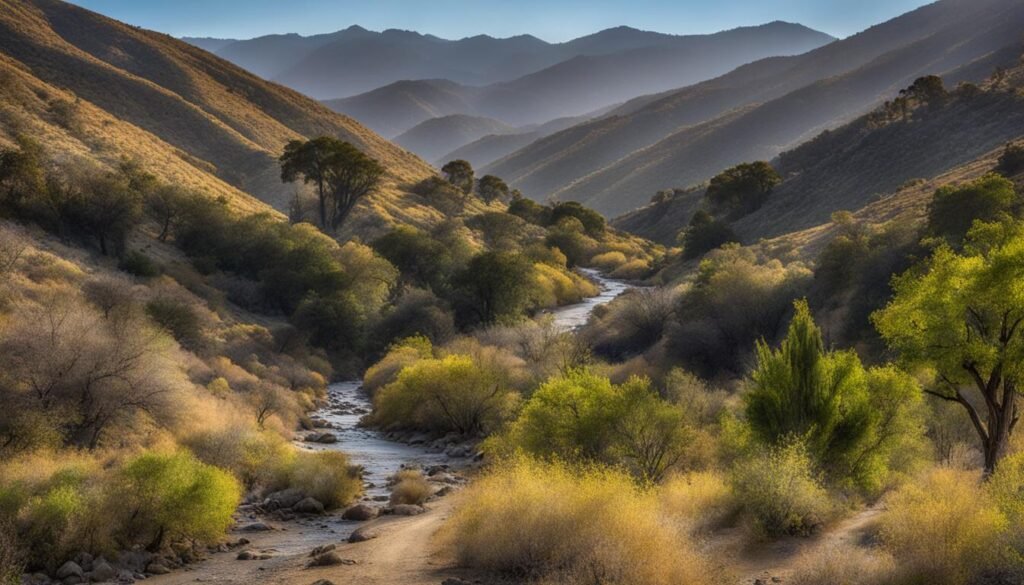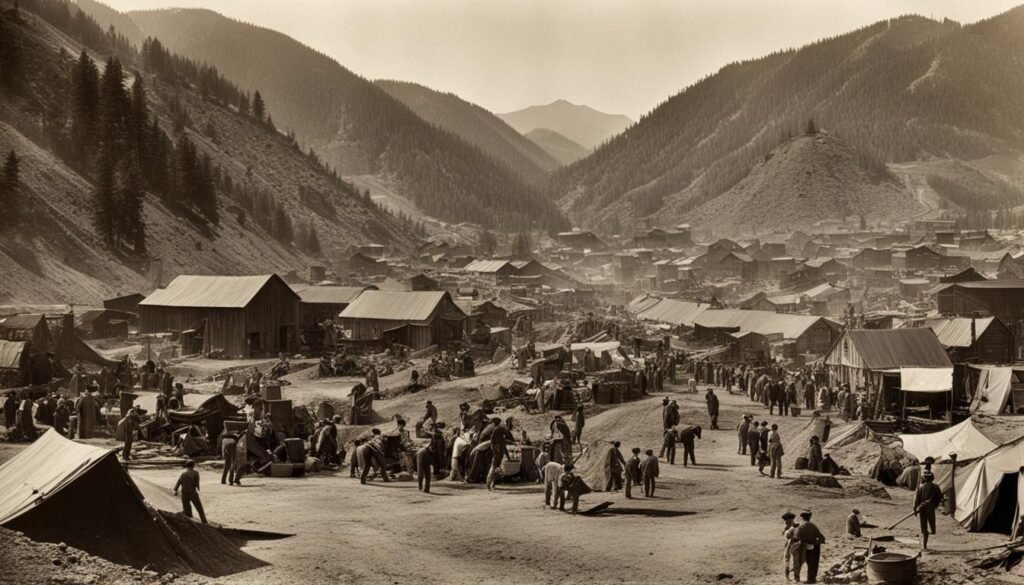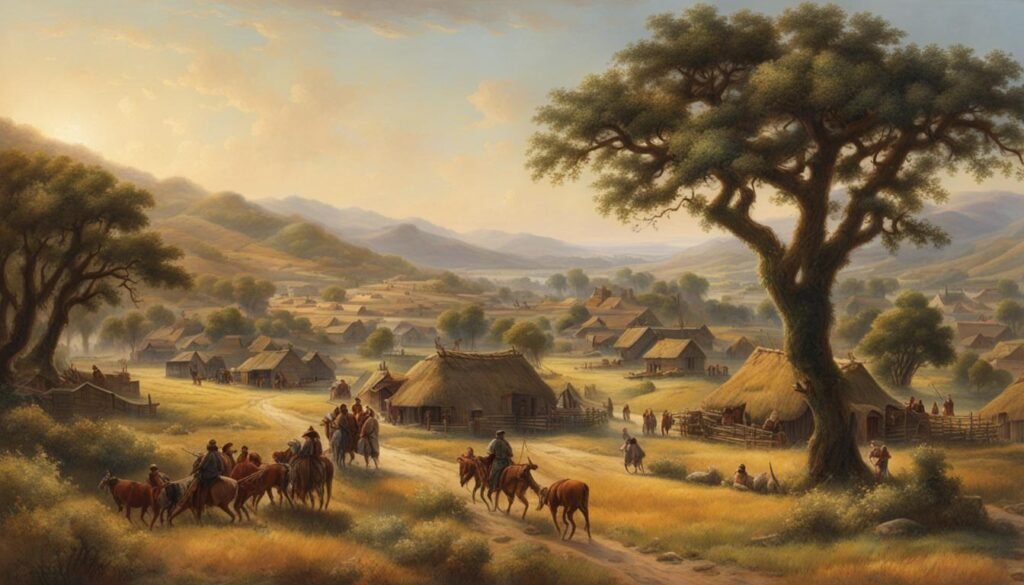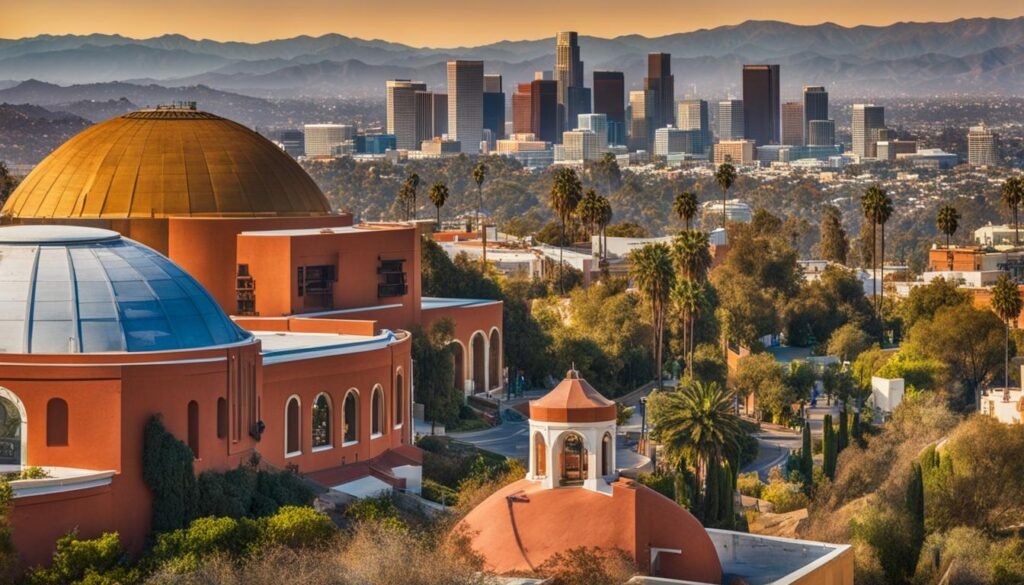As an avid traveler and history enthusiast, I’m always on the lookout for captivating stories that shed light on the past. One such tale that has piqued my interest is that of Juan Bautista de Anza and his remarkable expedition. The Juan Bautista de Anza National Historic Trail, spanning over 1200 miles, retraces the footsteps of this Spanish commander and the nearly 300 colonists who embarked on an ambitious journey in 1775-1776.
The trail itself embodies the spirit of exploration and preservation, commemorating the enduring elements of Spanish colonization in California. From the presidio and mission to the historic town, numerous sites along the trail hold significant cultural and historical value, earning them a spot in the esteemed National Register of Historic Places.
Key Takeaways:
- The Juan Bautista de Anza National Historic Trail traces the route of Spanish commander Juan Bautista de Anza II and his expedition in 1775-1776.
- The trail preserves and commemorates elements of Spanish colonization, including the presidio, mission, and town.
- Many sites along the trail are listed in the National Register of Historic Places, highlighting their historical and cultural significance.
- The trail offers a unique opportunity to explore the rich history of California and experience the impact of Juan Bautista de Anza’s journey firsthand.
- By following the footsteps of Juan Bautista de Anza, visitors can gain insights into the Spanish colonization of California and appreciate the contributions of this visionary leader.
Juan Bautista de Anza: A Trailblazing Expedition
In 1774, Juan Bautista de Anza embarked on the de Anza Expedition, with the goal of proving the existence of a land route from Mexico to Alta California. This daring expedition marked the beginning of a remarkable journey that would change the course of California history.
After the success of his first expedition, Anza was granted permission to recruit settlers for a second colonizing expedition. In October 1775, Anza led nearly 300 people on an epic journey that spanned over five months. Their final destination was the area that is now known as San Francisco, California.
This expedition laid the foundation for Spain’s presence in Alta California and opened up new possibilities for settlement and colonization. The courage and leadership of Juan Bautista de Anza paved the way for the establishment of the Presidio of San Francisco and the Mission Dolores, which would eventually become the city of San Francisco.
The de Anza Expedition is a testament to Anza’s achievements and his impact on the history of California. His trailblazing spirit and determination serve as an inspiration to this day.
Juan Bautista de Anza: Journey of a Trailblazer
- Juan Bautista de Anza Biography: Born in 1736 in the Sonoran Desert, Anza grew up in a military family and developed a passion for exploration and adventure from an early age.
- Juan Bautista de Anza Facts: Anza was a respected military officer, explorer, and leader. He held several prominent positions throughout his career and was known for his exceptional navigation skills and ability to forge alliances with Native American tribes.
- Juan Bautista de Anza Career: Anza’s career spanned over several decades, during which he played a significant role in expanding Spanish influence in the Americas. His expeditions opened up new territories and established vital trade routes.
- Juan Bautista de Anza Achievements: Anza’s most notable achievement was the de Anza Expedition, which successfully connected Mexico and Alta California. His leadership and determination proved instrumental in shaping the future of the region.
The de Anza Expedition remains an important part of California’s history, commemorated by the Juan Bautista de Anza National Historic Trail and its associated trail map. This trail offers a glimpse into the remarkable journey undertaken by Anza and his fellow explorers, allowing visitors to experience firsthand the challenges and triumphs they encountered along the way.
The Route of the Anza Trail: From Mexico to California
The Anza Trail is a historic route that spans over 1200 miles from Mexico to California. This challenging expedition, led by Juan Bautista de Anza, took the colonists through diverse landscapes including deserts and mountains, showcasing the determination and resilience of the pioneers.
The journey began in Mexico and ventured northward, passing through Tucson, Arizona. Along the way, the expedition made stops at notable sites such as Tumacácori National Historical Park and the Tubac Presidio State Historic Park, where travelers can still visit and learn about the rich history of this region.
Exploring Historical Landmarks
The Anza Trail continued through stunning natural landscapes, including Saguaro National Park and Casa Grande Ruins National Monument, providing breathtaking views and insights into the local flora and fauna.
As the expedition reached the Colorado River, the pioneers faced another challenge. Crossing this mighty river was a significant milestone in their journey. Once in California, the trail led them through Anza-Borrego Desert State Park, an awe-inspiring desert landscape that showcases the rugged beauty of the region.
Notable Mission Stops
Throughout their expedition, the travelers paid a visit to significant mission sites, including Mission San Xavier del Bac and Mission San Gabriel Arcangel. These missions played an essential role in early California history and are still beloved landmarks today.
Finally, after months of traversing varied terrain and enduring countless hardships, the Anza expedition reached its final destination in San Francisco. This journey was instrumental in shaping the history of California, and the Anza Trail stands as a testament to the incredible achievements of Juan Bautista de Anza and his fellow pioneers.
Anza’s Impact: Legacy and Contributions
Juan Bautista de Anza’s expedition had a profound and lasting impact on the history of California. The settlers who joined the expedition went on to establish significant landmarks that shaped the city of San Francisco. They founded the Presidio of San Francisco, a military fortification that played a crucial role in the region’s defense and development.
Another notable contribution was the establishment of the Mission de San Francisco de Asis, commonly known as Mission Dolores. This mission served as a spiritual and cultural center, contributing to the religious and social fabric of the community. Today, Mission Dolores remains a symbol of San Francisco’s rich historical heritage.
Furthermore, Juan Bautista de Anza’s expedition opened up a land route to California, solidifying Spain’s presence in the region. This journey secured Spain’s outposts and paved the way for future settlement and colonization. It was a pivotal moment in California’s history, as it provided an accessible route for migration and trade, laying the foundation for the development of the state.
The legacy of Juan Bautista de Anza and his expedition continues to be celebrated and revered today. The significance of his contributions to California’s history cannot be overstated, making him an integral figure in the state’s narrative. From the establishment of key institutions to the exploration of new territories, Juan Bautista de Anza’s impact resonates throughout the annals of California’s past.
- Establishment of the Presidio of San Francisco
- Founding of Mission Dolores
- Opening of a land route to California
Exploring the Juan Bautista de Anza National Historic Trail
Travelers can immerse themselves in the rich history of the Juan Bautista de Anza National Historic Trail and experience the same footsteps of the historic expedition. This trail offers a multitude of fascinating sites to visit, allowing visitors to connect with the past and gain insight into the remarkable journey led by Juan Bautista de Anza.
Starting the trail in Nogales, Arizona, you can explore the Anza Trailhead Room, where the adventure begins. Delve into the stories and artifacts that showcase the early days of the expedition. From there, the trail leads to various historic stops such as Tumacácori National Historical Park, the Tubac Presidio State Historic Park, and the iconic Mission San Xavier del Bac.
For nature enthusiasts, the trail also offers opportunities to discover stunning landscapes and national parks. Explore the breathtaking beauty of Saguaro National Park, where the mighty saguaro cacti dominate the scenery. Admire the ancient ruins preserved at Casa Grande Ruins National Monument, offering insights into the ancestral Sonoran Desert people.
To truly appreciate the vastness and beauty of the region, a visit to Anza-Borrego Desert State Park is a must. Marvel at the expansive desert landscape, bursting with vibrant wildflowers during the spring season.
The Juan Bautista de Anza National Historic Trail provides an extensive gallery of history, culture, and natural wonders. Through the exploration of these significant sites, visitors can gain a deeper understanding of Juan Bautista de Anza’s journey and his impact on California’s history.

Discover Juan Bautista de Anza’s Legacy
- Visit the Anza Trailhead Room in Nogales, Arizona, and begin your journey through history at the very spot where it all started.
- Explore Tumacácori National Historical Park and walk in the footsteps of the early Spanish colonizers.
- Step back in time at the Tubac Presidio State Historic Park and discover the preserved history of the region.
- Immerse yourself in the architectural masterpiece of Mission San Xavier del Bac, a testament to the enduring legacy of Spanish colonization.
- Experience the breathtaking landscapes of Saguaro National Park and marvel at the majestic saguaro cacti.
- Journey into the past at Casa Grande Ruins National Monument and explore the ancient ruins of the Sonoran Desert people.
- Witness the wonders of the Anza-Borrego Desert State Park, where the vast beauty of the desert unfolds.
Embark on your own historical odyssey along the Juan Bautista de Anza National Historic Trail and uncover the captivating stories of courage, exploration, and discovery.
AIANTA Partnership: Highlighting Tribal Destinations
As we explore the Juan Bautista de Anza National Historic Trail, it’s essential to recognize and celebrate the Indigenous communities that have called this land their home for centuries. That’s why AIANTA (American Indian Alaska Native Tourism Association) has collaborated with the National Park Service to highlight the tribal destinations along or near the trail. This significant partnership aims to promote and preserve the cultural heritage of the tribes, showcasing their contributions to the history and legacy of the trail.
Educational Webinars and Guidebook
AIANTA and the National Park Service have come together to create educational webinars that offer insights into the Indigenous homelands along the Juan Bautista de Anza National Historic Trail. These webinars provide a platform for tribal members to share their knowledge, stories, and traditions, enriching the trail experience for visitors.
In addition, a printed and online guidebook has been developed to showcase the tribal attractions found along the trail. This guidebook serves as a valuable resource for visitors, offering a deeper understanding of the Indigenous place names, histories, and cultural significance associated with each destination.
Map of Indigenous Homelands
To further highlight the Indigenous connection to the land, AIANTA and the National Park Service have created a map that identifies Indigenous homelands through traditional place names and significant sites. This map serves as a visual representation of the deep-rooted ties between the tribes and their ancestral territories along the trail.
This collaborative effort works to ensure that the tribal attractions and cultural heritage along the Juan Bautista de Anza National Historic Trail are recognized, respected, and preserved for future generations. By incorporating Indigenous perspectives, traditions, and histories, visitors can gain a more holistic understanding of the trail and the people who have shaped its identity over time.
The Anza Trail Today and Commemorating 250 Years
As we approach the years 2025 and 2026, a significant anniversary is on the horizon – the 250th anniversary of the Anza Expedition. This historic journey led by Juan Bautista de Anza holds immense importance, and efforts are underway to honor and commemorate this remarkable milestone.
The Juan Bautista de Anza National Historic Trail remains an integral part of public history, offering a unique opportunity for education, recreation, and exploration. By following in the footsteps of Anza and his fellow colonists, visitors can delve into the rich tapestry of California’s past and experience firsthand the challenges they faced along the way.
To aid in this exploration, the National Park Service provides an interactive map of the Anza Trail. This user-friendly tool allows visitors to customize their own journey, mapping out their preferred route and gaining valuable insights into the historical sites and landmarks they will encounter.

By utilizing the Anza Trail interactive map, enthusiasts can plan their expedition according to their interests, time constraints, and desired destinations. Whether it’s tracing the route from Mexico to California or exploring specific segments of the trail, this resource ensures a memorable and tailored experience.
From vast deserts to majestic mountains, the Anza Trail takes visitors on a captivating journey through various terrains, revealing the beauty and historical significance of the regions it traverses. It’s not just a trail; it’s a portal to the past, allowing us to immerse ourselves in the footsteps of those who shaped California’s history.
The upcoming 250th anniversary of the Anza Expedition presents an excellent opportunity for individuals and families to engage with this enduring legacy. Whether you’re a history buff, an outdoor enthusiast, or simply curious about the past, the Anza Trail offers an enriching experience that connects the present to California’s captivating history.
Come and experience the Anza Trail today, and be a part of the commemoration of Juan Bautista de Anza’s historic journey that continues to inspire and captivate us after 250 years.
Conclusion
The Juan Bautista de Anza National Historic Trail is a remarkable testament to the impact and legacy of Juan Bautista de Anza and his expedition. This historic trail, spanning from Mexico to California, allows visitors to immerse themselves in the journey taken by Anza and his colonists, providing a unique glimpse into the Spanish colonization of the region.
Today, the Juan Bautista de Anza National Historic Trail is an invitation for exploration and discovery, offering an extraordinary opportunity to uncover the rich history and cultural heritage of the places along the route. From the stunning landscapes to the preserved historical sites, the trail serves as a valuable resource for understanding and appreciating the enduring contributions of Juan Bautista de Anza to California’s vibrant history.
Whether you are seeking adventure, education, or a deeper connection to the past, the Juan Bautista de Anza National Historic Trail welcomes you to embark on a journey through time. As you traverse this historic path, you will be enchanted by the stories of the past and inspired by the enduring legacy of Juan Bautista de Anza. Come and experience the beauty and significance of the Juan Bautista de Anza National Historic Trail and immerse yourself in the remarkable history of California.
FAQ
What is the Juan Bautista de Anza National Historic Trail?
The Juan Bautista de Anza National Historic Trail is a route that spans over 1200 miles and follows the path taken by Spanish commander Juan Bautista de Anza II and his expedition in 1775-1776. The trail commemorates Spanish colonization and includes significant historical sites.
Who was Juan Bautista de Anza?
Juan Bautista de Anza was a Spanish commander who led expeditions to prove the existence of a land route from Mexico to Alta California in the 18th century. His second colonizing expedition in 1775-1776 had a lasting impact on California history.
What is the route of the Anza Trail?
The Anza Trail begins in Mexico and passes over 1200 miles of varied terrain, including deserts and mountains, to reach California. It passes through historic sites in Arizona, such as Tumacácori National Historical Park and the Tubac Presidio State Historic Park, before crossing into California and ending in San Francisco.
What is the legacy of Juan Bautista de Anza?
Juan Bautista de Anza’s expedition led to the establishment of the Presidio of San Francisco and Mission Dolores, laying the foundation for the city of San Francisco. His journey also secured Spain’s presence in Alta California and opened up a land route to the region.
Can visitors explore the Anza Trail?
Yes, travelers can explore the Juan Bautista de Anza National Historic Trail and visit various historical sites along the route. There are opportunities to learn about Juan Bautista de Anza and experience the expedition firsthand.
Are there tribal attractions along the Anza Trail?
Yes, the American Indian Alaska Native Tourism Association has partnered with the National Park Service to highlight tribal destinations along or near the Anza Trail. This partnership aims to promote and preserve the cultural heritage of the tribes in the region.
How can I plan my trip on the Anza Trail?
The National Park Service provides an interactive map of the Anza Trail, allowing visitors to customize their own trip and learn more about the historical sites along the way.
What is the significance of the Juan Bautista de Anza National Historic Trail?
The Juan Bautista de Anza National Historic Trail is significant in preserving and showcasing the history of Spanish colonization and its impact on California. It is an important part of public history and offers educational and recreational opportunities.
Where can I find more information about the Anza Trail?
You can find more information about the Anza Trail on the official Juan Bautista de Anza National Historic Trail website. Additional resources, such as news, updates, interviews, and galleries, may also be available.







